Are you looking to get rid of that old tattoo and start fresh with a new look? Before you make the decision to get your tattoo removed, it’s important to know how long it will take to get the tattoo removed. Depending on the size, color, and type of ink used for the tattoo, the time it takes to get the tattoo removed can vary. In this article, we’ll discuss how long it typically takes to remove a tattoo and what to expect throughout the process.
Contents
Overview of Tattoo Removal
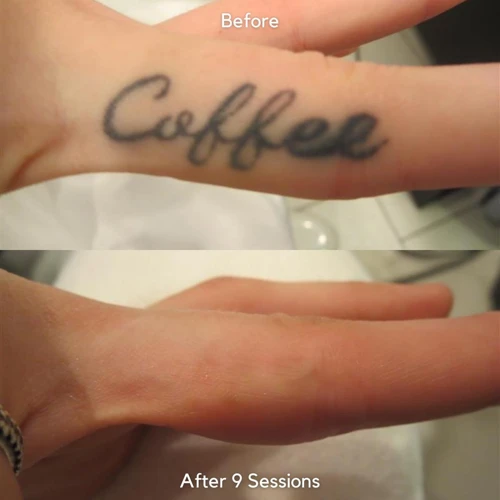
Tattoo removal is the process of removing unwanted tattoos. It can be done in a variety of ways, such as laser removal, surgical removal, chemical peels, and more. Depending on the size and color of the tattoo, the process of tattoo removal can take anywhere from a few weeks to months or even years.
- Laser tattoo removal, which is the most popular method, uses a laser to break down the ink in the tattoo and gradually lighten the tattoo.
- Surgical tattoo removal involves cutting the tattoo out of the skin and stitching the area back together.
- Chemical peels are used to remove the outer layers of skin, which can lighten or remove the tattoo.
- Dermabrasion is a method of tattoo removal that involves using a sanding tool to remove the outer layers of skin, which can lighten or remove the tattoo.
No matter which method is chosen, how long does laser tattoo removal take will depend on the size and color of the tattoo, as well as the number of treatments needed. In general, laser tattoo removal will take several sessions to complete, with each session lasting between 15 minutes and an hour. The number of sessions needed will depend on the size and type of tattoo, and the individual’s healing process.
Types of Tattoo Removal
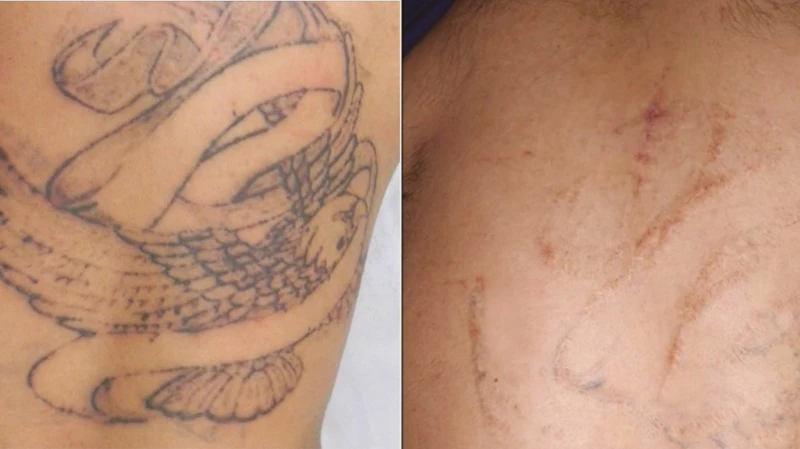
Laser Tattoo Removal
Laser tattoo removal is the most popular method of tattoo removal. It involves the use of laser energy to break down the ink molecules, which are then eliminated by the body. On average, it takes between 6 and 12 laser treatments to fully remove a tattoo. The amount of time it takes to remove a tattoo using laser tattoo removal depends on the size, age, and location of the tattoo.
Dermabrasion
Dermabrasion is an abrasive method of tattoo removal that uses a special device to sand away the top layers of skin. This method can be painful and is usually not recommended for larger tattoos. On average, it takes between 8 and 10 treatments to remove a tattoo with dermabrasion.
Intense Pulsed Light Treatments
Intense pulsed light treatments use a light source to break down the ink molecules in tattoos. It is less painful than laser tattoo removal and is often used for small tattoos. On average, it takes between 2 and 5 treatments to fully remove a tattoo with intense pulsed light treatments.
Salabrasion
Salabrasion is an older method of tattoo removal that involves the use of salt, water, and an abrasive substance to scrub away the top layers of skin. It is not commonly used, as it can be painful and can cause scarring. On average, it takes between 8 and 10 treatments to remove a tattoo with salabrasion.
No matter which method you choose, it is important to understand that no tattoo removal method will work overnight. Depending on the size and complexity of the tattoo, it can take up to several months to remove a tattoo, so it is important to be patient. If you are considering getting a tattoo removed, it is best to speak to a professional to find out how long it will take to laser off a tattoo.
Factors Affecting Tattoo Removal Time
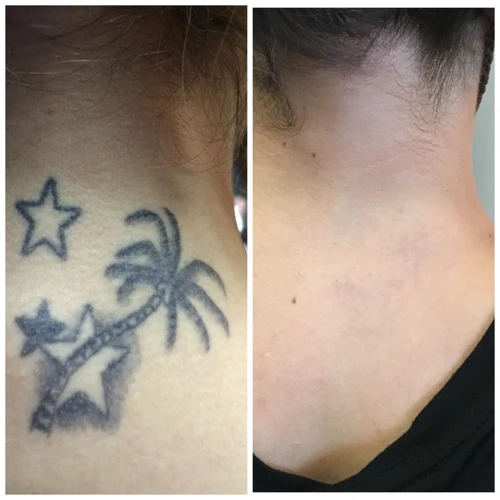
Tattoo Age
The age of your tattoo is one of the main factors in determining how long it takes to remove it. Newer tattoos are easier to remove because the ink is still near the surface. Older tattoos may take longer to remove because the ink has had time to sink further into the skin.
Tattoo Ink Color
Tattoo ink colors can also affect the removal process. Lighter colors such as yellow, orange, and green absorb laser energy more easily, making them easier to remove, while darker colors such as black and blue are more difficult to remove.
Tattoo Size
The size of the tattoo also plays a role in how long it will take to remove it. Smaller tattoos can be removed more quickly than larger ones because they require fewer laser treatments.
Tattoo Placement
The placement of the tattoo can also affect the removal process. Tattoos on areas of the body with more skin and fat, such as the thighs, are easier to remove because the laser energy is spread over a larger area. Tattoos on areas with less skin and fat, such as the hands and feet, are more difficult to remove.
Skin Type
Your skin type can also affect the amount of time it takes to remove a tattoo. People with darker skin tones may take longer to remove a tattoo because the laser energy is more difficult to absorb.
Number of Treatments
The number of treatments required to remove a tattoo can vary depending on the factors mentioned above. Generally speaking, it may take anywhere from 3 to 10 laser treatments to remove a tattoo. Laser tattoo removal usually requires multiple sessions spaced several weeks apart in order to allow the body time to heal in between treatments.
Overall, the amount of time it takes to remove a tattoo depends on various factors, such as tattoo age, ink color, size, placement, skin type, and the number of treatments required. With the right laser tattoo removal treatment plan, you can get rid of your unwanted tattoo and get ready for a new look.
How Long Does Laser Tattoo Removal Take?
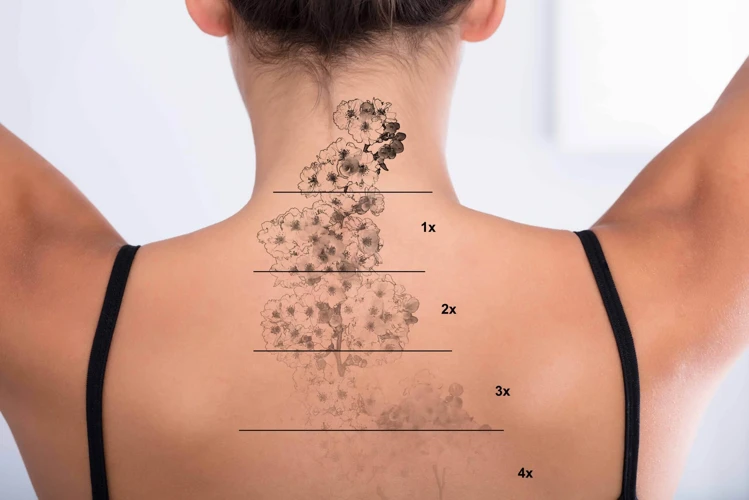
The time for laser tattoo removal depends on several factors like size, color, and location of the tattoo. It also depends on the type of laser used, the number of treatments and the patient’s skin type.
Small Tattoos: Small tattoos can be removed in just a few sessions, with each session typically lasting about 10 minutes.
Medium Tattoos: Medium tattoos usually take between 5-10 sessions, depending on the complexity of the design. Each session can last up to 20 minutes.
Large Tattoos: Large tattoos may take up to 15 or more sessions. Each session can last up to 30 minutes or more.
Color of Tattoo: Darker colors, such as black and blue, respond better to laser tattoo removal than lighter colors. As a result, darker tattoos may require fewer treatments than lighter tattoos.
Location: Tattoos located in sensitive areas, such as the face, may take longer to remove than tattoos located in less sensitive areas.
Skin Type: People with darker skin may require more treatments than those with lighter skin.
In general, it can take anywhere from a few sessions to several months to remove a tattoo. On average, it takes about 6-10 treatments for a full removal, with each session spaced about 6-8 weeks apart.
| Tattoo size | Number of treatments | Duration of each session |
|---|---|---|
| Small | 2-3 | 10 minutes |
| Medium | 5-10 | 20 minutes |
| Large | 15+ | 30 minutes or more |
Though laser tattoo removal can take several months to complete, it is an effective way to get rid of an unwanted tattoo. Depending on the size and color of the tattoo, it can take anywhere from a few sessions to several months to fully remove it.
Pros & Cons of Tattoo Removal
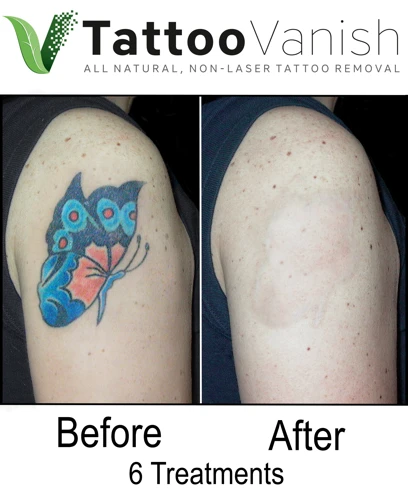
- Pros
- You can undo a mistake.
- You can get a fresh start with a new design.
- You can remove a tattoo that no longer reflects your identity.
- You can remove a tattoo that is embarrassing or no longer meaningful.
- Cons
- It can be expensive.
- It can take several treatments to completely remove a tattoo.
- It can be painful.
- It can cause scarring.
- It can cause changes in skin pigmentation.
Cost of Tattoo Removal
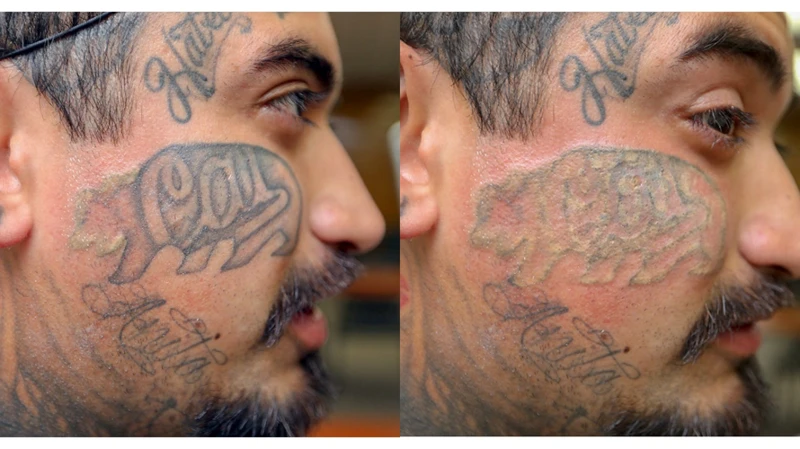
| Treatment | Price |
|---|---|
| Laser Tattoo Removal | Starting from $150 |
| Derma Sweep Tattoo Removal | Starting from $250 |
| Surgical Excision | Starting from $500 |
| Dermabrasion | Starting from $700 |
The cost of tattoo removal depends on the type of treatment chosen, the size of the tattoo, and the number of sessions required. Laser tattoo removal is the most popular and most effective method of removing a tattoo, but it is also the most expensive. Laser treatments start at $150 per session and may require multiple sessions. Derma Sweep tattoo removal is a newer, less expensive technique and usually costs $250 per session. Surgical excision and dermabrasion are two other alternatives, but they are more expensive, with prices starting at $500 and $700 per session, respectively.
Alternatives to Tattoo Removal
Tattoo removal is a long and expensive process. There are, however, alternatives to tattoo removal that can help you achieve your desired look. Here are some of the most popular:
- Cover-up Tattoos: Cover-up tattoos are a great way to hide an existing tattoo. They involve tattooing over the existing tattoo with a design of your choice. This is an effective way to hide the tattoo and can even result in an even more beautiful design than the original.
- Tattoo Camouflage: This is a less permanent option than cover-up tattoos, but it is just as effective. Tattoo camouflage involves using pigments to fill in the existing tattoo in order to make it less visible. This is a good option for those who don’t want a completely new tattoo.
- Tattoo Fading: This is an option for those who don’t want to completely remove their tattoo. Tattoo fading involves using laser treatments to lighten the tattoo, making it less visible. This is a less invasive option than full tattoo removal and can be a good choice if you don’t want to go through the full process.
- Tattoo Removal Creams: There are a variety of creams available on the market that claim to be able to fade or remove tattoos. While these creams may be able to lighten the tattoo, they are not as effective as laser treatments and may cause skin irritation or other side effects.
These are just a few of the alternatives to tattoo removal that you can explore if you don’t want to get rid of your tattoo completely. It is important to do your research and talk to a professional before deciding on which option is best for you.
Frequently Asked Questions
What is the Best Method for Tattoo Removal?
The best method for tattoo removal is laser-based treatments, such as Q-switched laser treatments. This method is safe, effective, and has minimal side-effects. The laser energy breaks down the tattoo ink into smaller particles, which are then absorbed and removed by the body’s lymphatic system. These treatments usually require several sessions spaced several weeks apart, and the number of sessions needed depends on the size, color, and location of the tattoo.
How Much Does The Tattoo Removal Process Cost?
The cost of tattoo removal depends on a range of factors:
- Size of the tattoo
- Location of the tattoo
- Type of ink used
- Number of treatments required
- Experience of the tattoo removal specialist
Generally, small tattoos can cost anywhere between $50 and $200 per session. Larger tattoos may need multiple sessions, and cost up to $500 per session. However, the price can vary greatly depending on the above factors, and the type of tattoo removal method used.
What are the Potential Risks Associated with Tattoo Removal?
Tattoo removal treatments can cause scarring, burning, and even infection. In rare cases, the risk of nerve damage or tissue damage can occur. It is important to discuss any potential risks with the doctor prior to starting any treatment. Additionally, the skin may become more sensitive to UV rays and require extra protection from sun exposure.
Can all tattoos be removed?
Yes. Tattoos can be removed with laser therapy or surgery. Laser therapy is the most common method of tattoo removal, and it works by breaking down the pigment of the tattoo with a laser. Surgery is sometimes used to remove larger tattoos.
- Laser therapy is the most commonly used method of tattoo removal. It works by breaking down the pigment of the tattoo with a laser.
- Surgery is sometimes necessary to remove larger tattoos.
- Skin grafting is an option for those who have had their tattoos removed but still have scars.
- Topical creams can help reduce the appearance of tattoos, but they do not completely remove them.
It is important to consult with a medical professional before deciding on a tattoo removal method, as some methods may not be suitable for all skin types. There are also risks associated with each method, so it is important to understand the potential side effects before proceeding.
Are there any post-treatment precautions to be taken after tattoo removal?
It is important to follow the aftercare instructions provided by the tattoo removal clinic. Immediately after the treatment, the skin will be sensitive and may feel tender. To reduce discomfort, it is recommended to use a cold compress and an antibiotic cream. It is also important to avoid direct sunlight and wear loose clothing over the treated area. Additionally, it is advised to keep the area clean and dry to avoid infections. Lastly, contact the clinic if any suspicious changes occur or if any adverse reactions occur.
Conclusion
Tattoo removal is a long and arduous process, but it is possible to get rid of unwanted tattoos. Depending on the size, color, and age of the tattoo, the process can take anywhere from several weeks to several months. Before committing to tattoo removal, it is important to research the available methods and discuss the risks and benefits with a doctor. With the right preparation and care, it is possible to get a new look and start fresh with a tattoo-free life.